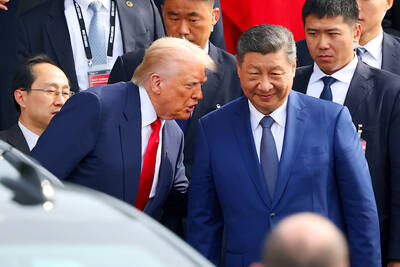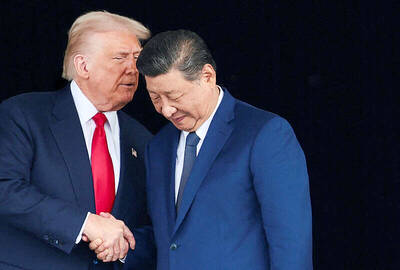Google unveiled its new Nexus One smartphone on Tuesday in a direct challenge to heavyweight Apple’s iPhone handsets.
The Internet giant billed the touch-screen device, the culmination of collaboration with Taiwanese electronics titan HTC (宏達電), a “superphone” that marked the next step in the evolution of its Android software.
“I think you will see it pushes the limits of what’s possible on a smart phone,” HTC chief executive Peter Chou (周永明) said as the smartphone debuted at Google headquarters in Mountain View, California. “It is very thin and feels good in your hand.”
Nexus One handsets are no thicker than pencils and no heavier than Swiss Army knife key chains, Google engineer Erick Tseng (曾毅立) said while demonstrating one of the smartphones.
“It is a great marriage of form and function,” Tseng said.
Nexus One smartphones are built on the same Android 2.1 software that runs Droid smartphones that recently hit the market with innovations like 3D graphics, Tseng said. The handsets also feature new speech command capabilities that allow users to dictate e-mails, text messages or Internet search queries.
Google launched its own online store, where the Nexus One will be sold.
“This is really a Google phone,” Interpret analyst Michael Gartenberg said. “A lot of the Android phones that came to market are kind of lackluster. One of the ways to avoid mediocrity is to kick things up a couple of notches yourself.”
Nexus One smartphones will be sold at the Google-hosted Web store for US$529 “unlocked,” without ties to a telecom carrier. But the handsets will be offered starting at US$179 if paired with T-Mobile service contracts in the US.
Google has made “strategic partnerships” with telecom firm Verizon in US and Vodafone in Europe. Nexus One devices linked to service from Verizon in the US and Vodafone in Europe should be available by mid-year, Google said.
Google said it would ship Nexus One devices to buyers in Singapore, Hong Kong, the UK and the US.
The smartphones are designed to work with a variety of telecom carrier networks.
“You can take out your SIM card from any provider and put it in the phone,” Google vice president of product management Mario Queiroz said.
The Internet search and advertising giant has a foothold in the market with its Android mobile operating system, featured in more than 20 phones since starting with T-Mobile’s G1 in October 2008.
“Google made it very clear that all Android devices are created equal, but some devices are created more equally than others,” Gartenberg said.
“They’ve raised the bar for their partners and they’ve tried to raise the bar for the ecosystem. They’ve clearly shown how they want to be a player,” he said.
Analysts have expressed concern that Google’s move could irk partners backing handsets based on the Internet firm’s open-source Android software.
“I don’t see it as a threat,” said Sanjay Jha, chief of mobile devices at handset titan Motorola, which recently brought to market a Droid smartphone based on Android software.
Also See: HTC revenue drops 31% in Q4

CALL FOR SUPPORT: President William Lai called on lawmakers across party lines to ensure the livelihood of Taiwanese and that national security is protected President William Lai (賴清德) yesterday called for bipartisan support for Taiwan’s investment in self-defense capabilities at the christening and launch of two coast guard vessels at CSBC Corp, Taiwan’s (台灣國際造船) shipyard in Kaohsiung. The Taipei (台北) is the fourth and final ship of the Chiayi-class offshore patrol vessels, and the Siraya (西拉雅) is the Coast Guard Administration’s (CGA) first-ever ocean patrol vessel, the government said. The Taipei is the fourth and final ship of the Chiayi-class offshore patrol vessels with a displacement of about 4,000 tonnes, Lai said. This ship class was ordered as a result of former president Tsai Ing-wen’s (蔡英文) 2018

UKRAINE, NVIDIA: The US leader said the subject of Russia’s war had come up ‘very strongly,’ while Jenson Huang was hoping that the conversation was good Chinese President Xi Jinping (習近平) and US President Donald Trump had differing takes following their meeting in Busan, South Korea, yesterday. Xi said that the two sides should complete follow-up work as soon as possible to deliver tangible results that would provide “peace of mind” to China, the US and the rest of the world, while Trump hailed the “great success” of the talks. The two discussed trade, including a deal to reduce tariffs slapped on China for its role in the fentanyl trade, as well as cooperation in ending the war in Ukraine, among other issues, but they did not mention

HOTEL HIRING: An official said that hoteliers could begin hiring migrant workers next year, but must adhere to a rule requiring a NT$2,000 salary hike for Taiwanese The government is to allow the hospitality industry to recruit mid-level migrant workers for housekeeping and three other lines of work after the Executive Yuan yesterday approved a proposal by the Ministry of Labor. A shortage of workers at hotels and accommodation facilities was discussed at a meeting of the legislature’s Transportation Committee. A 2023 survey conducted by the Tourism Administration found that Taiwan’s lodging industry was short of about 6,600 housekeeping and cleaning workers, the agency said in a report to the committee. The shortage of workers in the industry is being studied, the report said. Hotel and Lodging Division Deputy Director Cheng

‘SECRETS’: While saying China would not attack during his presidency, Donald Trump declined to say how Washington would respond if Beijing were to take military action US President Donald Trump said that China would not take military action against Taiwan while he is president, as the Chinese leaders “know the consequences.” Trump made the statement during an interview on CBS’ 60 Minutes program that aired on Sunday, a few days after his meeting with Chinese President Xi Jinping (習近平) in South Korea. “He [Xi] has openly said, and his people have openly said at meetings, ‘we would never do anything while President Trump is president,’ because they know the consequences,” Trump said in the interview. However, he repeatedly declined to say exactly how Washington would respond in